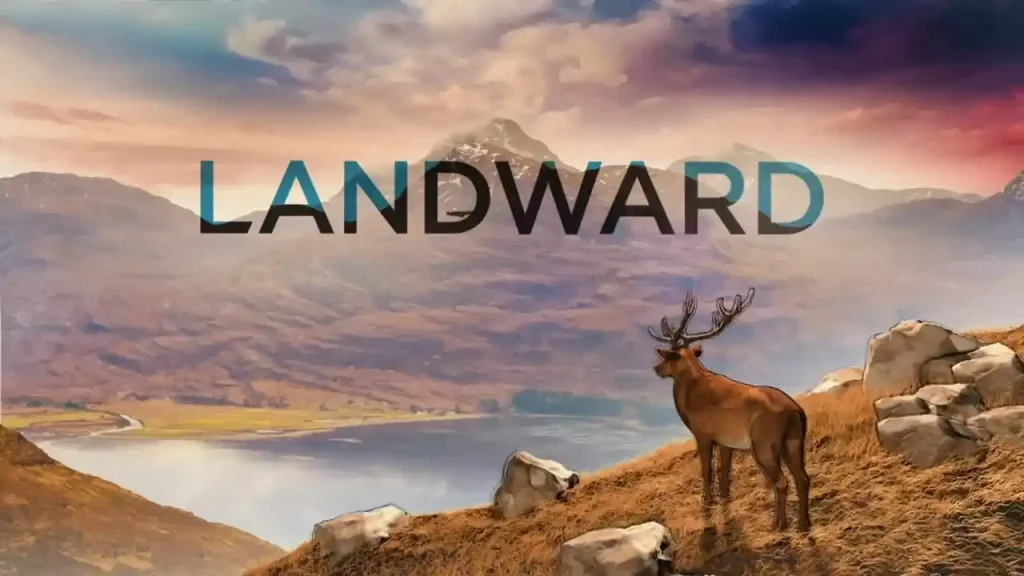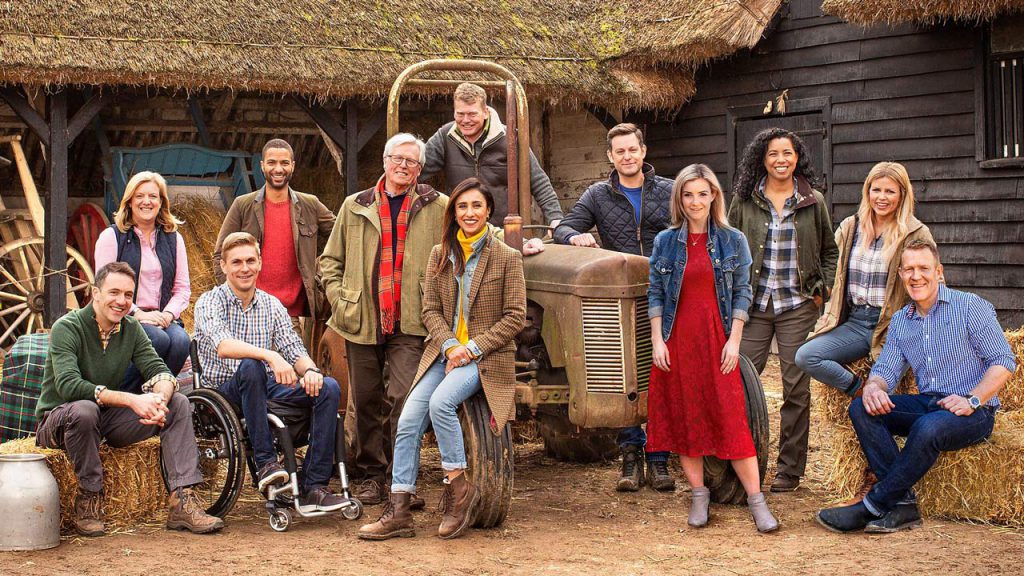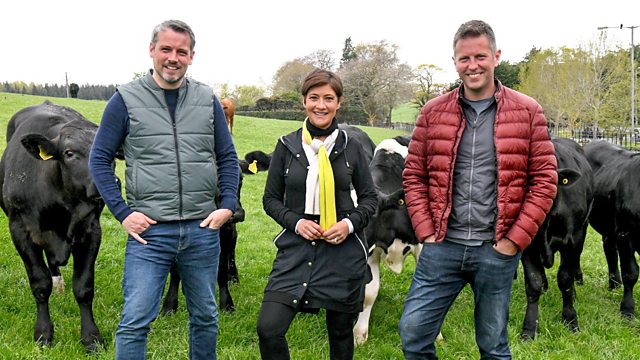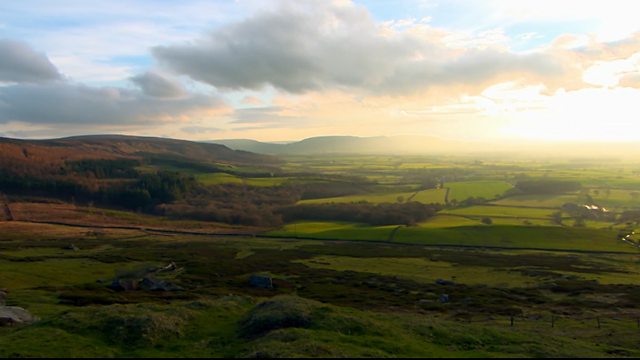Landward episode 24 2023 – Dougie embarks on an early morning journey to witness the breathtaking spectacle of barnacle geese taking flight from the Solway Firth. In this serene setting, he delves into the reasons behind their annual migration from the Arctic to this specific location every autumn. His exploration sheds light on how these birds are making a remarkable recovery following a significant setback caused by an outbreak of avian flu.
Meanwhile, Cammy ventures further inland to the historic and picturesque town of Gretna. Here, he meets with a local farming family who have made the tough decision to sell their renowned collection of pedigree cattle. This segment offers a deeper look into the challenges and changes faced by traditional farming communities.
Not far from the bustling city of Edinburgh, in the tranquil Pentland Hills, Arlene is immersing herself in the world of equestrianism. She takes a riding lesson on a robust breed of Icelandic horses, known for their extraordinary and unique gait that sets them apart from other horse breeds. This segment highlights the adaptability and distinct characteristics of these hardy horses.
In the lush green landscapes of Ayrshire, Anne discovers the unique role of Mangalitsa pigs. These special pigs are contributing to the environment by engaging in bracken control. This story illustrates an innovative approach to natural land management, where animals play a key role in maintaining the balance of the ecosystem.
Finally, Shahbaz returns with his expert eye for photography. He shares valuable tips for capturing the essence of the autumn season through a lens. In addition, he takes time to select and showcase his favorite viewer-submitted photographs, each embodying the rich and vibrant themes of autumn. This segment not only educates viewers on photography techniques but also celebrates the beauty of the season as seen through the eyes of the community.
Landward episode 24 2023 – A Journey Through Scotland’s Enchanting Landscapes and Wildlife
Witness Nature’s Spectacle as Thousands of Barnacle Geese Depart the Solway Firth
As dawn’s light creeps over the horizon, I set up my camera on the misty shore of the Solway Firth. This breathtaking spot where England borders Scotland hosts an avian phenomenon from late September through November – the arrival of some 40,000 migratory Barnacle geese fleeing the harsh Arctic winter. They make an epic journey spanning over 1,000 miles to reach these nourishing mudflats and surrounding fields.
The swirling fog begins dissipating as I hear their distinctive honking sounds. Suddenly, great waves of geese materialize overhead before my eyes. The flock aerates in a mesmerizing aerial dance, weaving and bobbing smoothly in synchrony. As the rising sun rays filter through the clouds, they ignite the birds’ bellies with a glow, presenting endless opportunities for spectacular photos.
Why Do Barnacle Geese Migrate Here?
The Barnacle geese choose the Solway Firth for its ideal habitat during winter. The combination of rich feeding grounds on the mudflats and nearby farmlands provides them nourishment to survive until springtime. They form lifelong bonds with their mates during migration. So year after year, the same pairs reunite and faithfully return together to this winter haven.
While here, the birds must consume enough protein and calories to prepare for their return flight to the Russian and Norwegian Arctic in March. Their primary dietary staples on the mudflats consist of eelgrass roots, tubers of glasswort plants, and algae. Venturing further afield to graze inland, they favor grass pastures and winter cereal crops like barley and wheat.
Farmers welcome the geese to boost biodiversity and sustain populations. And while the birds do nibble on crops, research shows they select fields of re-growth, mostly just gleaning spilled grains without negatively impacting yields or profitability.
Threats Facing Barnacle Geese Populations
While over 40,000 Barnacle geese overwinter by the Solway Firth, worrying threats face them and Arctic geese worldwide. Since their migration paths traverse many countries, they remain vulnerable to hunting and wetland habitat loss along their flyways.
Additionally, outbreaks of avian influenza have led to mass mortality events, severely impacting populations. For example, the devastating H5N1 outbreak in 2005 and 2006 killed thousands of Barnacle geese across Europe. But since those tragic years, intensive conservation efforts now see Barnacle numbers rebounding within sustainable thresholds.
Appreciating the Rapturous Rhythms of Nature
As I observe wave upon wave of geese passing overhead, I immerse myself in nature’s rapturous rhythms. Flocks arrive and depart with the tides in endless succession. Their Herculean migrations link summer and winter habitats across continents in profound interconnectedness. Watching these resilient birds surviving year after year through countless millennia remains deeply moving.
The geese follow ancestral pathways engrained into generations past and future. By returning here seasonally, they imprint the landscape with transcendent meaning all creatures intrinsically share – the promise of renewal that each springtime brings as light and life return.
Further inland, I venture into Scotland’s Pentland Hills to connect with nature through a distinctly Scandinavian experience – riding one of the country’s 400 purebred Icelandic horses. This hardy breed carries an ancient lineage tracing back to 9th century Viking imports that crossed the North Atlantic. They became isolated for a thousand years with no outside bloodlines introduced. So the Icelandic horse remains the world’s purest equine breed. Their unique genetics endowed them with a special gait unlike any other horse on earth.
The Icelandic Horse’s Glacial Origins
Icelandic horses descend from small, sturdy ponies that migrated to Iceland with Viking settlers. They later became isolated for a millennium with no external breed influences. This created a uniquely pure bloodline perfectly adapted to Iceland’s rugged terrain and severe climate.
The breed’s characteristic resilience comes from ancestral wild horses that survived Ice Age glaciations in Siberia and Europe. Their double coat of hollow, water-resistant hairs and insulating undercoat helps them regulate body temperature and withstand the frigid Icelandic winters. Their compact shape, muscular build, and broad hooves handle icy footing.
Through long isolation from other breeds, Icelandic genetics consolidated unique traits over generations. Today’s Icelandic displays distinct conformational features true to their ancient predecessors. They have expressive heads with straight profiles, thick manes and tails, and short coupled frames.
Discovering the Icelandic’s Special Fifth Gait
As I saddle up my Icelandic steed, named Glanni, what immediately commands my attention beyond the breed’s striking physique is their remarkable smooth-running gait. I discover firsthand their special fifth gait giving them worldwide distinction from other horse types – the tölt. This fast, flowing four-beat lateral ambling gait offers unparalleled riding comfort.
The tölt’s captivating rhythm springs from the horse powerfully engaging its hindquarters to propel forward fluidly without hardly jostling the rider. Having four independent gaits allows the Icelandic to quicken or slow its pace instantly as terrain conditions change. Their unique ambling tölt gait spans speeds matching a canter or gallop in other breeds but in delightful harmony with the rider. This rare ability likely emerged as Icelandics traversed their native rugged landscapes for over 1,000 years.
As Glanni effortlessly tölts up the Pentland Hills wet trail, I sway rhythmically absorbing each subtle movement. My guide explains this congenital gait transmits through specific neurosensory signals rather than conformational traits. So crossbreeding programs cannot pass it down reliably. That’s why ancestral isolation preserved this treasured gait only inherent in purebred natives of Iceland spanning over 40 generations.
Ensuring the Survival of this Cherished Breed
With Icelandics being genetically vulnerable due to their limited gene pool, diligent conservational breeding aims to sustain breed health over generations. The international Icelandic Horse Association leads these endeavors through strict registration policies. Iceland itself forbids importing horses to protect native purity critical for retention of special fifth gaits like tölt.
Riding programs worldwide cultivate enthusiasm in youth to become future stewards. As I dismount smiling ear to ear from experiencing Glanni’s graceful ambling tölt outpacing our trek, I recognize what a truly exceptional opportunity this is. I’ve connected intimately to an ancient breed now numbering over 300,000 worldwide that carries a timeless legacy. My heart fills with motivation to safeguard Icelandics so future riders can know their preserve their rare gifts.
Bearing Witness to a Prestigious Highland Cattle Herd’s Final Days before Dispersal
I detour inland to the quaint town of Gretna, just over the Scottish side of the border. Here I have a somber encounter with the farming Boyd family congregated outside their stockyard. They’ve raised pedigree Highland cattle for over 30 years, achieving acclaim in agricultural showings and breeding circles. But today marks the dispersal sale of their entire elite herd.
Upon their weathered faces, expressions mingle of fond nostalgia and sorrow in having to bid farewell to these magnificent beasts. The new generation holds no ambition, it seems, to continue the esteemed bloodlines. I can’t help sharing in the Boyd family’s grief over this being the prestigious herd’s last stand.
At the same time, the family retains dignity and optimism establishing new ventures. Life’s cycles ever evolve. As one chapter ends, opportunity rises for their cattle stock to seed new beginnings elsewhere now.
The Storied History of Highland Cattle in Scotland
Native to the rugged Scottish Highlands, Highland cattle carry a genetic lineage spanning many centuries. Their long wavy coats, sweeping horns, and hardiness endure weather extremes on remote mountain terrain during harsh winters.
As Scotland’s oldest registered breed, they hold an eminent status with devoted breed societies established since 1884. The breed is treasured as a cultural icon with images gracing all Tourism Scotland branding.
The Boyds certainly played their part establishing genetic prominence through many generations. Their sires and dams won broad acclaim at regional agricultural shows.
A Celebrated Herd Meets Its End
Today over 100 head of cattle pace nervously in enclosures surrounding the auction floor filled with observers. I notice magnificent beasts bearing the Boyds’ ear tags entering the ring in groups to become sold to the highest bidder.
One imposing bull with a stud fee reaching towards £10K strides in with heads held high. Breeders in the crowd gesture competitively until the prized sire gets hammered down for £17,000 to an esteemed Highland Cattle Society member.
My heart clutches witnessing irreplaceable breeding lines dissolving. Yet I equally share joy for enthusiasts able to purchase superior specimens to grow new herds.
Highland Cattle Temperament and Welfare
If this magnificent breed has one defining attribute beyond physical brawn, it is temperament. Highlands rank among the most docile and laidback cattle types. Their calm manner permits roaming freely over lands in Scotland.
Seeing the Boyds’ cows nudging them affectionately for scratches and treats highlights tight bonds between caretaker and herd. These cattle thrive on personal attention. Selling to owners who respect sentimental attachments no doubt brought comfort during difficult proceedings today.
While the dispersal results shine as a breed conservation success with elite bloodlines finding worthy new homes, I cannot deny feeling melancholy. Witnessing this lovingly nurtured herd hitting the auction block signals profound life change rippling through farms worldwide. Mechanization and commercial forces reshaping agriculture make sustaining generational farming dreams challenging.
Yet the humble courage in the Boyds’ eyes as they accept transition with grace and humanity heartens me. For life expectancy never guarantees outcomes we envision. Its gift lies in participating fully through all seasons – including those we cannot yet understand.
Restoring Scotland’s Woodlands One Bracken-Eating Pig at a Time
Venturing onward to the ancient Kilkerran forest near Ayrshire, I discover an ingenious program to regenerate struggling woodlands without herbicides – Mangalitsa pigs! These marvelous Hungarian wooly swine possess one magical trait catapulting them to stardom – voracious bracken consumption unmatched by other grazing livestock.
How Overabundant Bracken Devastates Forest Understories
Bracken fern infarctions increasingly burden forests worldwide, destroying native plant diversity and songbird habitats. Rapid spreading rhizomal root networks emit chemicals hindering competing vegetation. They also release carcinogenic spores. Eventually all underbrush vanishes leaving empty woodland floors.
Managing uncontrolled bracken remains overwhelmingly expensive using mechanical flailing or aerial glyphosate spraying with environmental consequences. But Kilkerran’s foresters made an ecological breakthrough. They unleashed an armada of bracken-munching Mangalitsa pigs that hunt fronds with astounding precision without disturbing tree roots or soil. Their selective grazing gives native flora fighting chance to recover.
Hungary’s Marvelous Wooly Mangalitsas Find Niche as Conservation Pigs
Coming face to snout with three jolly Mangalitsas enthusiastically crunching bracken, I’m wholly smitten by these charismatic beasts. Their golden curled coats and friendly manners captivate me as they merrily scour each fern stand. Conservation leader Simon Jones details how Kilkerran imported registered breeding stock of this Hungarian heritage pig. Mangalitsas possess unique digestive enzymes metabolizing bracken plant toxins other livestock can’t tolerate. This enables them to thrive on the invasive fern.
Seeing bracken disappearing under the power of conservation pigs, I gain profound appreciation for wise forest stewardship. Rather than waging chemical warfare, Kilkerran activated natural processes through insightful animal integration. Now native tree saplings gain footing. Woodland songbirds return as understory vegetation diversifies. And the delightful Mangalitsas prosper on their luscious bracken meal plan!
Building Future-Forward Conservation Plans
My day with Mangalitsa pigs inspires hope that compassionate human ingenuity can rewrite destructive tales. I foresee expansive opportunities for this commanding breed and its likes to facilitate landscape healing globally. Their hardy constitution and keystone browsing habits make them ideal agents enacting positive transformation without environmentally questionable methods.
My early cynicism about modern agriculture now gives way to heartfelt admiration witnessing farmers take risks on forward-thinking land practices guided by core values of sustainability and nurturing ancestral breeds that benefit ecosystems. Just perhaps happy Mangalitsas munching trailing bracken symbolize coming decades where human welfare entwines more thoughtfully with our surrounding ecology through responsible stewardship.
Photography Lessons to Capture Scotland’s Rugged Beauty in Breathtaking Images
Before my Scotland journey concludes, professional photographer Shahbaz pauses our group amidst a crimson canopy of woodland color to offer practical tips capturing compelling nature images even using phones. His top suggestion – patience. Excellent wildlife and landscape shots await those lingering to deeply observe nature’s artistic expressions.
Engaging Emotion Through Visual Storytelling
Shahbaz coaches us how strong photos progress beyond basic beauty. Images best connecting with others feature intriguing drama and emotion. Know your desired story or mood, then incorporate elements visually accentuating feelings using angling, lighting, and negative space. Lead the eye deliberately across frame. Play creatively with foregrounds and backgrounds.
Mastering Quality Light
Truly phenomenal images bank on sublime lighting whether sparkling sunrays, moody fog, or warm sunsets. So dedicate time discovering optimal daily windows. Then revisit chosen subjects during ideal conditions. Contrast backlighting to intensify silhouettes. Diffuse fronts to minimize shadows. And intentionally expose for brighter or darker ambiance.
Ethical Field Practices
While seeking perfect shots, remain conscientious of surroundings. Never disturb habitats or private lands without direct permissions. Retreat if wildlife seems distressed. Prioritize their wellbeing.
Use gear safely secured from dropping and weatherproofed if needed. Dress for extremes spending prolonged time outdoors. And follow leave no trace principles when traveling through remote regions.
Telling What Light Reveals
As we reflect on learnings, Shahbaz re-emphasizes respecting light’s revelations. Photography originates from Greek words meaning “drawing or painting with light”. So compositions should sing praise first to the landscapes and creatures being illuminated. Events unfolding before our eyes bear precious gifts if we wait patiently. The camera then serves only as instrument in their divine choreography.
I depart Scotland with profound inspiration toward purposeful seeing and deeper listening championed by new friends Shahbaz and the Landward team. Their courage to shine light on all facets of farm livelihood from both joyous and heartrending expands my empathy. Witnessing each soul give their finest through seasons of gain and loss reconnects to universal currents binding humanity. Now I recognize photography’s highest aim lies in truthfully telling the stories brought to light.
Conclusion – Landward episode 24 2023
My epic journey through Scotland’s magnificent landscapes and wildlife has profoundly moved and educated me. I observed countless migratory barnacle geese expertly tracing their ancestral routes. I experienced the Viking legacy firsthand while mastering the unique fifth gait of an Icelandic horse, a breed with a noble glacial heritage. And I found hope for sustainable land stewardship practices through Mangalitsa pigs restoring damaged forests.
The people I met along the way showed incredible passion and dedication, whether studying conservation science, breeding livestock, training horses, or capturing emotive photography. Their stories wove an intricate tapestry revealing how Scotland’s cultural identity binds intimately to the surrounding ecology.
I depart with inspiration to carry their courage and wisdom forward. The geese migrating faithfully across continents decade after decade demonstrate the might of collective purpose when living harmoniously as part of a greater whole. May we embrace our shared calling to steward the lands and creatures in our care with such noble spirit.
Frequently Asked Questions – Landward episode 24 2023
Why do barnacle geese choose Scotland as their overwintering grounds?
Barnacle geese migrate all the way from Arctic regions in Norway and Russia to overwinter by the Solway Firth in Scotland for its ideal habitat. The area provides rich feeding grounds on the mudflats and surrounding farmlands. This gives them enough nutrition to survive until their return flight in springtime.
What makes Icelandic horses unique from other breeds?
Icelandic horses boast the purest bloodlines of any breed since they remained isolated on Iceland with no outside genetic influences for over 1000 years. This gave them exceptional hardiness to withstand extreme climate. Their rare fifth gait called “tölt” also distinguishes them. This smooth-running four-beat lateral ambling gait offers unrivaled riding comfort across varied terrain.
Why was the Boyd family selling off their elite Highland Cattle herd?
After over 30 years raising premiere show and breeding Highland Cattle, the Boyd family held a dispersal sale for their entire herd when the next generation opted not to continue the cattle farming operation. The new owners gain exceptional breeding lines to grow the Highland Cattle population.
How are Mangalitsa pigs helping restore Scotland’s forests?
Mangalitsa pigs possess unique digestive enzymes that allow them to consume invasive bracken plants that damage undergrowth diversity in forests. Their voracious bracken grazing helps native plants recover while supporting organic restoration of struggling woodlands. Their conservation value continues rising across Scotland.
What makes a photograph emotionally compelling?
Shahbaz encourages photographers to go beyond basic beauty and incorporate intentional drama within images that stirs deeper feelings. Consider foregrounds/backgrounds, lighting angles and other elements that accentuate the desired mood and lead the viewer’s eye compellingly across the frame. Masterful visual storytelling requires planning and patience.




